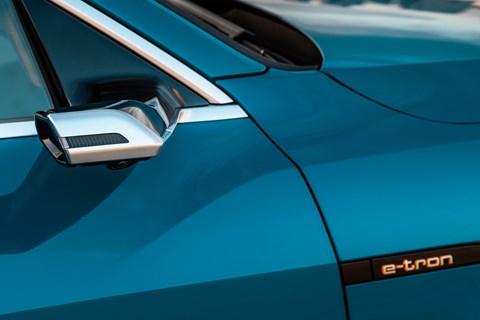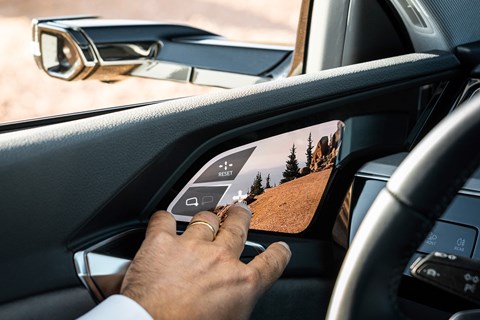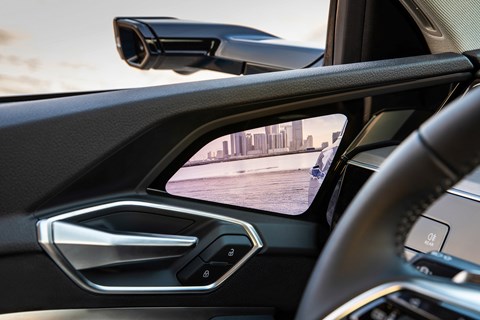► Audi’s virtual mirrors
► Lower drag, higher cost
► How do they work?
Now this is taking some serious mental recalibration. Twenty-six years spent glancing out of side windows at wing mirrors has to be unlearned in a single day, because for the first time on a production car there are no exterior mirrors – they’ve been replaced by cameras that relay your rear view on cockpit screens. Welcome to Audi’s virtual exterior mirrors.
The system is standard on the £82,240 Launch Edition of Audi’s new e-Tron electric SUV, or a £1240 option on lesser trims. The reasoning is pretty simple: swap chunky protuberances for more compact cameras. Critically this reduces turbulence, enough to shave the e-Tron’s drag co-efficient from 0.28 to 0.27. That can deliver up to four miles of additional travel – and the range-anxious will take every mile they can get.
The view behind is relayed on screens positioned in the uppermost part of the door trim, lined up with the outer edge of the dashboard. Adjusting their view is a similar experience to using regular powered mirror switches. Tap the screen and icons come up, enabling you to select which mirror you want to adjust, then swipe your finger within a gunsight to tweak the picture angle. The lens is heated to prevent it misting up or freezing over. The camera adjusts to the ambient light conditions, to ensure consistency of image as you sweep in and out of tunnels.

And it automatically changes the view depending on the use case – when you’re parking, for instance. Unfortunately this is rubbish: cars that appear perilously close on the screen are in fact a couple of metres away. That’ll give the Chelsea tractor brigade an excuse to park inconsiderately. Another snag is glare on the screens, though the picture resolution is of high quality. But the biggest beef I have is with the screens’ positioning: they are mounted too low. Anything that requires you to drop your sight below the window line is a retrograde step, denying drivers peripheral information about what’s going on around them. They would be much better placed at the base of the A-pillars, so big on modern cars they’re often a frustrating blindspot.
A nice touch is the way the screen’s perimeter flashes when a car is approaching your blindspot. But any goodwill is sure to evaporate when a clumsy passing driver smashes the camera; Audi quotes £300-£400 for various individual replacement parts. So getting one fixed is going to add up.
Three ways to redefine a wing mirror
Mount a camera
Side-mounted cameras are heated to keep the view clear, and crucially reduce drag.

Tweak the view
Use your finger to alter the view, and the view adjusts itself if you’re parking, turning or on a motorway.
Watch the screens
The picture resolution is good, but they’re set too low and subject to glare from the sun.

Audi e-trom digital mirrors: does it work?
It works adequately. But it’s no safety improvement yet. The screens can be obscured by fierce sun glare, but the biggest problem is that they’re mounted lower than regular door mirrors. This led to a lot of glancing in the wrong place when driving the e-Tron, though owners will get used to it. We appreciate the aerodynamic benefit. But for now it feels like a tech that needs to mature, to improve on today’s low-tech but effective mirrors.
Check out more Tech news here